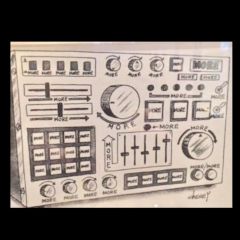
karlson3
Regulars-
Posts
390 -
Joined
-
Last visited
Recent Profile Visitors
3654 profile views
karlson3's Achievements

Forum Veteran (4/9)
74
Reputation
-
EV Sentry III Midrange Horns (SM120A, EV1823M)
karlson3 replied to Jer_Hy's topic in Technical/Restorations
I'm talking about a 2nd order highpass for the midhorn driver vs just a cap (Type A/AA) The inductor is parallel with the horn driver (in this case right before a fixed resistor L-pad) making it "2nd order" (electrical if not acoustic) Here's a Sentry IV schematic - look at "T1" - that's the inductor but this copy (from these forums) is illegible. (Is that "3mH" ? "5mH" ?) - Sentry IV users probably know. The basshorn is good within its range and think a late - great Ray Newman design. With strong 12" even Kappa 12A, Sentry IV is louder in the upper mids than a K-horn (but limited in LF extension) (Pyle's PYM1298 was made by Eminence and pretty much the same driver as their Kappa12A) -
EV Sentry III Midrange Horns (SM120A, EV1823M)
karlson3 replied to Jer_Hy's topic in Technical/Restorations
good observation absolve2525- IIRC my 1823M were 8 ohms nominal vs 16 for a K55V. - SM120 was the only horn in my test to have a weird dip vs Cobraflex and 511. Its 1/4 wave path is awfully short and made for a bad match . Odd order networks can exhibit wild interactions with driver/horn;cabinet impedance peaks and dips. -
EV Sentry III Midrange Horns (SM120A, EV1823M)
karlson3 replied to Jer_Hy's topic in Technical/Restorations
Some years back I made a comparison of a number of horns with a 24uF cap and junk EV CDP driver with the rear exit plugged. With the driver, SM120 exhibited a response dip towards the bottom which looked like the devil sign made with hand and fingers. (that response problem did not occur with my K55V) At the time I had the idea it was partly due to the relatively short horn path and where the impedance dips and peaks lay. Do you have a shunt inductor across the driver? If not I'd try one. -
La Scala/doghouse: Was there a reason ...
karlson3 replied to Dave MacKay's topic in Technical/Restorations
Here's the Belle with 50 liter back chamber vs a simple closed box, both with K33 spec for comparison -
they do create some mild (?) lobing IIRC - didn't see much deep stuff. If there's still a graph of mine outdoors then would be in a nearly 20 year old pc. I probably had that graph with Imageshack who deleted my files (I had a paid account too) I don't know the size of these Westlake horns in the post linked below, but the smaller one was made without vanes - http://www.audioheritage.org/vbulletin/showthread.php?5425-Westlake-HF-Horns&p=49859&viewfull=1#post49859
-
Bob Smith's "Distributed Source Horn" was one inch high with no vertical expansion, and featured in the January 1951 issue of "AUDIO ENGINEERING" magazine. Tho considered antiquated by today's art, it can be quite "musical" - part of that is from being extremely well camped from thick^ construction plus the bracing effect of the vanes. ((* whomever built my set of Smithhorns used 3/4" dense plywood for the top and bottom plates and that was a good idea) "
-
The original 1" format "Smith Horn" imo. is an excellent sounding piece (especially with mono rigs). For size and for 3 way applications,. the "Smith Selsted" horn is intriguing. FWIW I might pick a horn height 00.7" and a B&C DE07 as the driver. Maybe DE10 - - - I'm not sure what size the horn might be made or what might happen if the dividing "vanes" are omitted. Do you guyz have any thoughts on how you would make this style horn? If not too large then could be economically 3D printed. It would look cool sitting on top of a 1 inch format Smith Horn (as shown in the original article) http://www.audioheritage.org/vbulletin/showthread.php?12697-Walnut-Smith-Selsted http://www.audioheritage.org/vbulletin/showthread.php?9871-Smith-Selsted-Tweeters
-
If interested...Klipsch Patents & Schematics
karlson3 replied to attycda's topic in Technical/Restorations
Cool ! - The Skew Horn" reminds me of Don Keele's 1983 paper http://www.xlrtechs.com/dbkeele.com/PDF/Keele (1983-10 AES Preprint) - Horn Covers Flat Rectangular Area.pdf -
a schematic from a crossover calculator only delivers the promised action if the drivers have very wide and flat bandwidth plus flat input impedance. Some horn - driver combos exhibit steep rolloff below cutoff and one reason why the late Bruce Edgar just used "1st order" sections as there were already many phase rotations . Other cases probably can use REW then export response and Z to a crossover simulator. yeah - you thought you were getting Sonicap - they may be better made than the Chinese Dayton caps. (where are Sonicap made?)
-
That's a really clean job of wiring. The electrolytic appears to pair a sizable film cap. (?) Those inductors look pretty pricey. What value and gauge is the big one? How about the small one - is it a foil coil ? FWIW I think there can be subtle differences between capacitors - whether soakage or ESR so some systems may sound better with an old PIO Russian cap - others with DC-link. I do like trying charge coupled. I've liked Mylar cap just fine with some speakers.
-
Hi ClaudeJ FWIW with aid of YouTube and ESS headphones (lock most sound "in" so no one is ever disturbed) I listen to opera, bluegrass, orchestral., percussion, old jazz, I'm not worried about cloning a speaker where one cabinet costs more than what my house and probably all its belongings are worth less than its cost. I just want the ability to understand differences in approach and how to choose. I'm 71 with heart failure, my house ruined while I was in the hospital in 2019 for an allergic reaction which put me on a ventilator for 9 days. My main interest are John Karlson's approaches (don't laugh as can be pretty good) and those aren't easy to sim. Even XRK971's Akabak2 sims are off in the basics of response and impedance. Akabak3 might come close if the model is sophisticated enough and requires AutoCad, Fusion 360 plus Akabak3 - all way beyond what my feeble brain can do. You can ask the moderator to remove the thread (I don't kn ow how) Best! Freddy PS - the sim from above and repeated below was for a K33 design - about 12 cujbic foot cabinet - if the horn would fit - lol It's pretty good on the low end but loses some on the top vs a K33 in a vented Ka Scala
-
La Scala/doghouse: Was there a reason ...
karlson3 replied to Dave MacKay's topic in Technical/Restorations
I had a friend suggest I could improve a Karlson box by filling the front with concrete. -
OOPS - had L34 in inches rather than cm and re-did it with L34 = 30 cm as assume that path has to be a bit more than half the baffle's width. I'll fix this mess later - the result of a usable L34 appears to drop the high end to around 200. K33 is a great spec for the low end. I'm sorry to clutter up this forum - hopefully I'll learn something which might be useful I might ask the moderator to remove the thread until I'm more confident with things. its baby steps - like one forwards then one back am getting closer to a buildable horn. The back chamber at 100 liters sans port and driver displacement would be less than 15 inches deep with a throat-baffle width of 18.5 inches and baffle height of 22.5". I don;'t know if the horn could fit a rectangular box 2ft by 2ft by 3ft. The final horn segment could be shortened from 70cm to 55 cm with a small hit in response but max efficiency (0.5 pi) would be 60% at ~53Hz - -nice for kickdrum. Maybe a wizard like ClaudeJ could fold this mess. I "did" very much like the size and predicted performance numbers - but that could not be built lol HERE is input with a minimum width for L34 - L34 has to be at the minimum one half the width of the "thraot-baffle" (that baffle is 18.5 inches wide in this case. It would not hurt to sim with a taller baffle and compare. This baffle width is about as narrow as can be made so the composite throat would be somewhat larger with a taller baffle. The low end stays strong but the top at best power-wise is F6 around 250Hz - so it might use a 150Hz tractrix midhorn drven by a hot pro 6 - 8 "inch speaker.



